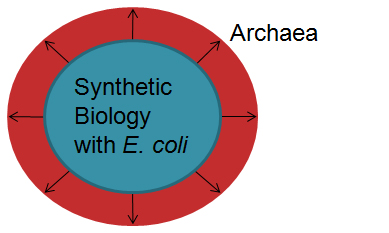Team:UGA-Georgia
From 2013.igem.org
(→Introduction) |
Hamptonite (Talk | contribs) (→Introduction) |
||
| (32 intermediate revisions not shown) | |||
| Line 4: | Line 4: | ||
<div id="header">{{Template:Team:UGA-Georgia/Templates/Header}}</div> | <div id="header">{{Template:Team:UGA-Georgia/Templates/Header}}</div> | ||
| - | + | =Welcome to the University of Georgia 2013 iGEM Team Wiki!= | |
| - | + | ||
| - | + | ||
| - | |||
== Introduction == | == Introduction == | ||
[[Image:Tshirtday.jpeg|right|frame]] | [[Image:Tshirtday.jpeg|right|frame]] | ||
| + | Over the past couple of decades metabolic engineering and synthetic biology has enabled researchers to develop biological systems for the purpose of producing pharmaceuticals, high value chemicals or other medical devices/ instruments. Most of the synthetic biology work is limited to ''E. coli''. Although ''E. coli'' has been heavily studied and utilized it does have its drawbacks, like requirement of specific temperatures and growth conditions. | ||
| - | + | With the intention of expanding synthetic biology beyond traditional approaches and biological platforms we dared to explore/expand its reach into archaea. The production of high value chemicals in archaea has the following advantages: | |
| + | <li> Using renewable carbon sources | ||
| + | <li> Methanogens can grow utilizing formate and hydrogen, making it superior to ''E. coli'' in terms of both growth conditions and cheap energy sources. | ||
| - | + | <p style="text-align:justify"> | |
| + | In this work we demonstrate the utility of chemicals production in archaea. We targeted the production of Geraniol as: | ||
| + | [http://www.sciencedirect.com/science/article/pii/S0254629910001559] | ||
| - | + | <li> It is reported to inhibit pancreatic and prostate cancers. | |
| + | <li> It has a higher energy density than Ethanol, thereby having better fuel properties. | ||
| + | <li> It can be used as a component of insect repellents. | ||
| + | <li> It can be used commercially as a flavoring agent and in perfumes. | ||
| - | == | + | == Abstract == |
| - | + | [[Image:E coli and archaea expansion.jpg|right]] | |
| + | |||
| + | '''Geraniol production via novel protein expression tools in ''Methanococcus maripaludis''''' | ||
| - | + | Geraniol is an intriguing 10 carbon compound with diverse applications including use as an agent for cancer prevention, fragrance, insect repellent, proposed biofuel etc. We explored and engineered a novel gene expression tool (BBa_K890000) for ''Methanococcus'' with the capability of expressing geraniol synthase from ''Ocimum basilicum'' (BBa_K1138000). We report the biosynthesis of geraniol at over 0.2% of DLW by transforming the vector into Methanococcus thereby expanding its native isoprenoid pathway. Furthermore we engineered new vectors (BBa_K1138001 & BBa_K1138002) with the potential capability of regulating and quantifying the expression of desired proteins via red fluorescence. This work demonstrates the use of ''Methanococcus'' as a cell factory for chemical production and highlights synthetic biology advancement by engineering new systems over traditional biological systems such as ''Escherichia coli''. | |
| - | + | ||
| - | + | ||
| - | + | ||
| - | + | ||
Latest revision as of 17:39, 27 September 2013
Welcome to the University of Georgia 2013 iGEM Team Wiki!
Introduction
Over the past couple of decades metabolic engineering and synthetic biology has enabled researchers to develop biological systems for the purpose of producing pharmaceuticals, high value chemicals or other medical devices/ instruments. Most of the synthetic biology work is limited to E. coli. Although E. coli has been heavily studied and utilized it does have its drawbacks, like requirement of specific temperatures and growth conditions.
With the intention of expanding synthetic biology beyond traditional approaches and biological platforms we dared to explore/expand its reach into archaea. The production of high value chemicals in archaea has the following advantages:
In this work we demonstrate the utility of chemicals production in archaea. We targeted the production of Geraniol as: [http://www.sciencedirect.com/science/article/pii/S0254629910001559]
Abstract
Geraniol production via novel protein expression tools in Methanococcus maripaludis
Geraniol is an intriguing 10 carbon compound with diverse applications including use as an agent for cancer prevention, fragrance, insect repellent, proposed biofuel etc. We explored and engineered a novel gene expression tool (BBa_K890000) for Methanococcus with the capability of expressing geraniol synthase from Ocimum basilicum (BBa_K1138000). We report the biosynthesis of geraniol at over 0.2% of DLW by transforming the vector into Methanococcus thereby expanding its native isoprenoid pathway. Furthermore we engineered new vectors (BBa_K1138001 & BBa_K1138002) with the potential capability of regulating and quantifying the expression of desired proteins via red fluorescence. This work demonstrates the use of Methanococcus as a cell factory for chemical production and highlights synthetic biology advancement by engineering new systems over traditional biological systems such as Escherichia coli. "
"


